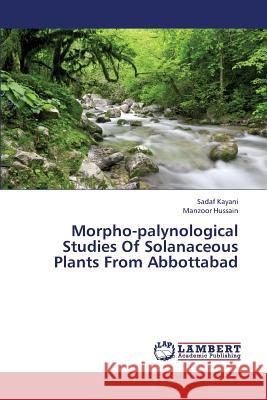Morpho-Palynological Studies of Solanaceous Plants from Abbottabad » książka
Morpho-Palynological Studies of Solanaceous Plants from Abbottabad
ISBN-13: 9783844393569 / Angielski / Miękka / 2013 / 84 str.
Morpho-Palynological Studies of Solanaceous Plants from Abbottabad
ISBN-13: 9783844393569 / Angielski / Miękka / 2013 / 84 str.
(netto: 169,97 VAT: 5%)
Najniższa cena z 30 dni: 178,89
ok. 10-14 dni roboczych
Bez gwarancji dostawy przed świętami
Darmowa dostawa!
Certain plants belonging to family Solanaceae growing in Abbottabad have been studies palynologically. During palynological investigation 10 genera and 23 species have been studied. In this way one species of Atropa, 02 species of Capsicum, 03 species of Cestrum, 03 species of Datura, 01 species of Hyoscyamus, 01 species of Lycopersicon, 02 species of Nicotiana, 02 species of Petunia, 06 species of Solanum and 02 species of Withania belonging to family Solanaceae have been studied. Solanaceae is a eurypalynous family. Grains usually 3 (4) colporate, radially symmetrical, isopolar, prolate-spheroidal to oblate-spheroidal to oblate spheroidal to sub-prolate to per prolate or suboblate to oblate, size range: 8.55 - 72 m amb circular, semiangular or subangular, aperture drop type, labrum common type, exine usually 2um thick, nexine 1-1.5 m thick. Tectum usually psilate, sexine reticulate, granulate or striato-reticulate, usually with OL or obscure pattern, 1-2 m thick, nexine 1-1.5 m thick. Most striking variation is found in the shape class, aperture type and tectal surface. The brief characteristic features of all members described in this work have been tabulated in Table-1.
Certain plants belonging to family Solanaceae growing in Abbottabad have been studies palynologically. During palynological investigation 10 genera and 23 species have been studied. In this way one species of Atropa, 02 species of Capsicum, 03 species of Cestrum, 03 species of Datura, 01 species of Hyoscyamus, 01 species of Lycopersicon, 02 species of Nicotiana, 02 species of Petunia, 06 species of Solanum and 02 species of Withania belonging to family Solanaceae have been studied. Solanaceae is a eurypalynous family. Grains usually 3 (4) colporate, radially symmetrical, isopolar, prolate-spheroidal to oblate-spheroidal to oblate spheroidal to sub-prolate to per prolate or suboblate to oblate, size range: 8.55 - 72 µm amb circular, semiangular or subangular, aperture drop type, labrum common type, exine usually 2um thick, nexine 1-1.5 µm thick. Tectum usually psilate, sexine reticulate, granulate or striato-reticulate, usually with OL or obscure pattern, 1-2 µm thick, nexine 1-1.5 µm thick. Most striking variation is found in the shape class, aperture type and tectal surface. The brief characteristic features of all members described in this work have been tabulated in Table-1.











